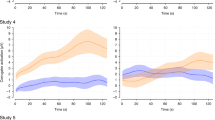Abstract
Central to equity and distributive justice theories is the assumption that reward inequities produce feelings of distress and that such feelings motivate efforts to reduce the perceived injustice. Physiological arousal under such conditions would provide direct evidence of injustice distress. To date, no such evidence exists. In the present study, a skin conductance measure was obtained for subjects receiving either just or unjust allocations in a pay-forwork setting. As expected, heightened arousal occurred (relative to baseline levels) in underpay and overpay conditions, with no such effect in a just-pay condition. It was also predicted and found that heart rate—more an index of somatic activity than distress—did not discriminate among experimental conditions. The implications of these results for theoretical development and applied research are discussed.
Similar content being viewed by others
References
Austin, W., and Walster, E. (1974). Reactions to confirmations and disconfirmations of expectancies of equity and inequity.J. Pers. Soc. Psychol. 30: 208–216.
Ben-Shakhar, G. (1985). Standardization within individuals: A simple method to neutralize individual differences in skin conductance.Psychophysiology 22: 292–299.
Berger, J., Zelditch, M., Anderson, B., and Cohen, B. P. (1972). Structural aspects of distributive justice: a status-value formulation. In Berger, J., Zelditch, M., and Anderson, B. (eds.),Sociological Theories in Progress, Vol. 2, Houghton-Mifflin, Boston.
Berger, J., Fisek, M. H., Norman, R. Z., and Wagner, D. G. (1983). Formation of reward expectations in status situations. In Berger, J., and Zelditch, M., Jr. (eds.),Status, Rewards and Influence, Jossey-Bass, San Francisco.
Bernstein, A. S., Taylor, K. W., and Weinstein, E. (1975). The phasic electrodermal response as a differentiated complex reflecting stimulus significance.Psychophysiology 12: 158–169.
Bierhoff, H. W., Cohen, R. L., and Greenberg, J. (eds.) (1986).Justice in Social Relations, Plenum Press, New York.
Bruning, J. L., and Kintz, B. L. (1977).Computational Handbook of Statistics, Scott, Foresman & Co., Glenview, IL.
Burdick, H. A., and Burnes, A. J. (1958). A test of “strain toward symmetry” theories.J. Abn. Soc. Psychol. 57: 367–370.
Cahn, E. (1949).The Sense of Injustice, New York University Press, New York.
Cohen, R. L. (1987). Distributive justice: theory and research.Soc. Justice Res. 1: 19–40.
Cook, K. S. (1987). Toward a more interdisciplinary research agenda: The potential contributions of sociology.Soc. Justice Res. 1: 5–18.
Cooper, J., and Fazio, R. H. (1984). A new look at dissonance theory. In Berkowitz, L. (ed.),Adv. Exp. Soc. Psychol. 17: 229–266.
Croyle, R. T., & Cooper, J. (1983). Dissonance arousal: Physiological evidence,J. Pers. Soc. Psychol. 45: 782–791.
Deutsch, M. (1985).Distributive Justice: A Socio-psychological Perspective, Yale University Press, New Haven, CT.
Elkin, R. A., and Leippe, M. R. (1986). Physiological arousal, dissonance, and attitude change: evidence for a dissonance-arousal link and a “don't remind me” effect.J. Pers. Soc. Psychol. 51: 55–65.
Farkas, A. J., and Anderson, N. H. (1979). Multidimensional input in equity theory.J. Pers. Soc. Psychol. 37: 879–896.
Fazio, R. H., and Cooper, J. (1983). Arousal in the dissonance process. In Cacioppo, J. T., and Petty, R. F. (eds.),Social Psychophysiology: A Sourcebook, Guilford, New York.
Folger, R. (ed.). (1984).The Sense of Injustice, Plenum Press, New York.
Fowles, D. C. (1980). The three arousal model: Implications of Gray's two-factor learning theory for heart rate, electrodermal activity and psychopathy.Psychophysiology 17: 87–104.
Fowles, D. C. (1982). Heart rate as an index of anixety: failure of a hypothesis. In Cacioppo, J. T., and Petty, R. E. (eds.),Perspectives in Cardiovascular Psychophysiology, Guilford, New York.
Fowles, D. C. (1983a). Appetitive motivational influences on heart rate.Pers. Indiv. Diff. 4: 393–401.
Fowles, D. C. (1983b). Motivational effects on heart rate and electrodermal activity: implications for research on personality and psychopathology.J. Res. Pers. 17: 48–71.
Fowles, D. C., Christie, M. J., Edelberg, R., Grings, W. W., Lykken, D. T., and Venables, P. H. (1981). Publication recommendations for electrodermal measurements.Psychophysiology 18: 232–239.
Gormly, J. (1971). Sociobehavioral and physiological responses to interpersonal disagreement.J. Exp. Res. Pers. 5: 216–222.
Gormly, J. (1974). A comparison of predictions from consistency and affect theories for arousal during interpersonal disagreement.J. Pers. Soc. Psychol. 30: 658–663.
Greenberg, J. (1984). On the apocryphal nature of inequity distress. In Folger, R. (ed.),The Sense of Injustice, Plenum Press, New York.
Greenberg, J., and Cohen, R. L. (eds.). (1982).Equity and Justice in Social Behavior, Academic Press, New York.
Hassett, J. (1978).A Primer of Psychophysiology, Freeman, San Francisco.
Jasso, G. (1986). A new representation of the just term in distributive-justice theory: its properties and operation in theoretical derivation and empirical estimation.J. Math. Sociol. 12: 251–274.
Katz, H., Cadoret, R. J., Hughes, K. R., and Abbey, D. S. (1965). Psychological correlates of acceptable and unacceptable attitude statements.Psychol. Rep. 17: 78.
Kirk, R. E. (1982).Experimental Design, 2nd ed., Brooks/Cole, Belmont, CA.
Lacey, J. I. (1959). Psychophysiological approaches to the evaluation of psycho-therapeutic process and outcome. In Rubenstein, E. A., and Parloff, M. B. (eds.),Research in Psychotherapy, American Psychological Assoc., Washington, DC.
McCurdy, H. D. (1950). Consciousness and the galvanometer.Psychol. Rev. 57: 322–327.
Markovsky, B. (1985). Toward a multilevel distributive justice theory.Am. Sociol. Rev. 50: 822–839.
Mellers, B. A. (1982). Equity judgments; A revision of Aristotelian views.J. Exp. Psychol.: Gen. 2: 242–270.
Messick, D. M., and Cook, K. S. (eds.). (1983).Equity Theory: Psychological and Sociological Perspectives, Praeger, New York.
Mikula, G. (ed.). (1980).Justice and Social Interaction, Springer-Verlag, New York.
Obrist, P. A. (1976). The cardiovascular-behavioral interaction — as it appears today.Psychophysiology 13: 95–107.
Olson, J. M., Herman, C. P., and Zanna, M. P. (eds.). (1986).Relative Deprivation and Social Comparison, Erlbaum, Hillsdale, NJ.
Roberts, L. (1974). Comparative psychophysiology of the electrodermal and cardiac control systems. In Obrist, P. A., Black, A. H., Brener, J., and DiCara, L. V. (eds.),Cardiovascular Psychophysiology: Current Issues in Response Mechanisms, Biofeedback, and Methodology, Aldine, Chicago.
Tornblom, K. (1977). Distributive justice: Typology and propositions.Hum. Rel. 30: 1–24.




